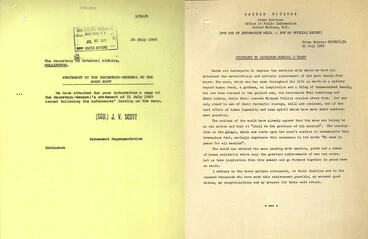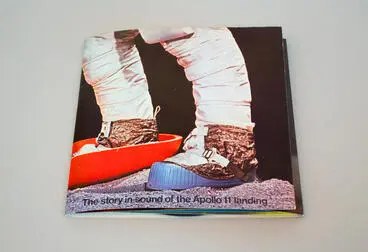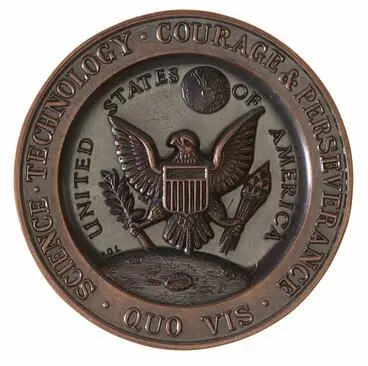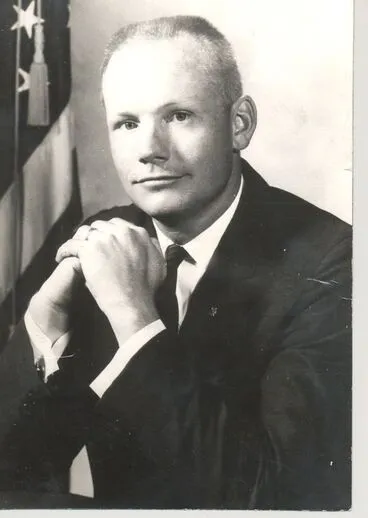The Moon Landing
A DigitalNZ Story by Zokoroa
A celebration of fifty years since Neil Armstrong and Buzz Aldrin set foot on the Moon in July 1969 during the Apollo II space flight.
Moon, Space exploration, Apollo, Neil Armstrong, Buzz Aldrin, Rockets, Outer space, Space, Lunar
Apollo 11 was launched by a Saturn V rocket from the Kennedy Space Center on Merritt Island, Florida on 16 July 1969 at 9:32 EDT. The spacecraft consisted of the command module Columbia and the lunar module Eagle. The crew were Neil Armstrong (commander), Buzz Aldrin (lunar module pilot) and Michael Collins (command module pilot). They travelled 240,000 miles from the Earth to the Moon in 76 hours. Armstrong and Aldrin landed the Eagle on 20 July 1969, at 4.17 pm EDT, while Collins flew the Columbia alone in lunar orbit. "Houston, Tranquility Base here. The Eagle has landed," Armstrong reported. See the NASA video of how the Moon looked as the Apollo landed. (CNN Library)
Celebrations mark 50 years since Apollo 11 launch
Radio New Zealand
Evans, Malcolm Paul, 1945- :Neil Armstrong, 1930-2012. 27 August 2012
Alexander Turnbull Library
Webb, Murray, 1947- :[Neil Armstrong]. 28 August 2012
Alexander Turnbull Library
After the Eagle landed, Armstrong became the first person to step onto the Moon six hours 39 minutes at 10.56 pm EDT later on 21 July. Armstrong's first step onto the lunar surface was broadcast on live TV to a worldwide audience. He described the event as "One small step for man, one giant leap for mankind."
Aldrin joined Armstrong approximately 19 minutes later at 11.15 pm EDT. They read from a plaque signed by the three crew members and the President of the United States Richard Nixon, "Here men from the planet Earth first set foot upon the Moon, July 1969 A.D. We came in peace for all mankind." At 11:48 pm EDT , President Nixon spoke with Armstrong and Aldrin via radio from the Oval Office, "Certainly has to be the most historic telephone call ever made." They speak for two minutes and the call is televised on both ends.
Buzz Aldrin descending from the lunar module onto the Moon's surface.
[Space Research - U.S.A. Apollo II Moon Landing]
Auckland War Memorial Museum Tāmaki Paenga Hira
Buzz Aldrin setting up a solar wind experiment next to the lunar module.
[Space Research - U.S.A. Apollo II Moon Landing]
Auckland War Memorial Museum Tāmaki Paenga Hira
Buzz Aldrin setting up equipment to measure seismic activity
[Space Research - U.S.A. Apollo II Moon Landing]
Auckland War Memorial Museum Tāmaki Paenga Hira
Armstrong and Aldrin spend over two hours collecting Moon rock samples and data, and spend the night on board the Eagle.
Man on Moon
Auckland War Memorial Museum Tāmaki Paenga Hira
Armstrong and Aldrin spent 21 hours 31 minutes at the site they named Tranquility Base before lifting off to rejoin Columbia in lunar orbit. After the Eagle docks with Columbia, the Moon rocks, data, and equipment are transferred and the Eagle is jettisoned. The crew then returned to Earth and splashed down in the Pacific Ocean on 24 July after more than eight days in space. They landed 900 miles from Hawaii, and went into quarantine aboard the USS Hornet until 10 August 1969.
Shows Neil Armstrong holding a flag stating, '21st century man' in front of an enormous footstep on the Moon.
Body, Guy Keverne, 1967-:'21st Century Man.' 27 August 2012
Alexander Turnbull Library
Lunar module Eagle ascending from the Moon surface, with the earth in the background.
[Space Research - U.S.A. Apollo II Moon Landing]
Auckland War Memorial Museum Tāmaki Paenga Hira
Dish operator at Parkes Observatory in NSW pointed the telescope at the Moon to pick up signals of the 69 moon landing.
Neil Mason - Dish Operator at Parkes Observatory
Radio New Zealand
NZ watched a delayed television broadcast of the Moon landing, which had been relayed via satellite dish from Australia.
1969 Lunar Landing
Archives New Zealand Te Rua Mahara o te Kāwanatanga
Moon landing footage flown on special delivery from Sydney
Radio New Zealand
The women of NASA's Apollo Missions
Radio New Zealand
Moon Rock
Museum of New Zealand Te Papa Tongarewa
Australia Historical Medal Society of Australia & New Zealand 1970.
Medal - Apollo XI Moon Landing, Historical Medal Society of Australia & New Zealand, Australia, 1969
Museums Victoria
Various conspiracy theories have been circulating over the past fifty years, that the moon landing was faked. (See Wikipedia).
Conspiracy theories state the Moon landing was staged in a studio.
Moon landing: fake or real? And other public-submitted questions for Hillary and Donald
The Spinoff
Forty years later some people still believed that the Moon landing was a hoax.
"We are satisfied though that a cow did in fact jump over the moon." 21 July 2009
Alexander Turnbull Library
40th anniversary of the original moonwalk by Neil Armstrong and Buzz Aldrin.
The world remembers the original moonwalkers, Neil Armstrong, Buzz Aldrin and Michael Jackson. 8 July 2009
Alexander Turnbull Library
Alex Malley (Chief of accounting firm CPA Australi) went to Ohio to interview 82-year-old reclusive Armstrong (2012).
An audience with Neil Armstrong
Radio New Zealand
Neil Armstrong (American Astronaut)
Kete Horowhenua
Neil Armstrong died aged 82 on 25 August 2012.
Scott, Thomas, 1947- :[Mankind saluting Neil Armstrong]. 29 August 2012
Alexander Turnbull Library
A new BBC series called '13 Minutes To The Moon' reconsiders the Moon landing and how close it came to failure.
'13 Minutes to the Moon': the moon landing reconsidered
Radio New Zealand
21 July 2019 marks 50 years since Neil Armstrong and Buzz Aldrin set foot on the Moon.
50 years since the Moon landing – Expert Reaction
Science Media Centre
Marking the 50th anniversary of the moon landing
Radio New Zealand
NASA chief scientist remembers moon landing
Radio New Zealand
Do you know your moon landing trivia?
Radio New Zealand
![[Space Research - U.S.A. Apollo II Moon Landing] Image: [Space Research - U.S.A. Apollo II Moon Landing]](https://thumbnailer.digitalnz.org/?resize=770x&src=https%3A%2F%2Fcollection-api.aucklandmuseum.com%2Frecords%2Fimages%2Fmedium%2F544847%2F2e4ef2f84d80a5f109cc5d23d736ec551aa77033.jpg&resize=368%253E)
![[Space Research - U.S.A. Apollo II Moon Landing] Image: [Space Research - U.S.A. Apollo II Moon Landing]](https://thumbnailer.digitalnz.org/?resize=770x&src=https%3A%2F%2Fcollection-api.aucklandmuseum.com%2Frecords%2Fimages%2Fmedium%2F544839%2F84d2db27da390ccef54187f6db8d35119cee96af.jpg&resize=368%253E)
![[Space Research - U.S.A. Apollo II Moon Landing] Image: [Space Research - U.S.A. Apollo II Moon Landing]](https://thumbnailer.digitalnz.org/?resize=770x&src=https%3A%2F%2Fcollection-api.aucklandmuseum.com%2Frecords%2Fimages%2Fmedium%2F544845%2Fee5b9c26be4bf9c203ea31a8e9bc8dd78a213901.jpg&resize=368%253E)

![[Space Research - U.S.A. Apollo II Moon Landing] Image: [Space Research - U.S.A. Apollo II Moon Landing]](https://thumbnailer.digitalnz.org/?resize=770x&src=https%3A%2F%2Fcollection-api.aucklandmuseum.com%2Frecords%2Fimages%2Fmedium%2F544851%2Fda029fe5a7997c60489d2129c46e624e28538a82.jpg&resize=368%253E)





